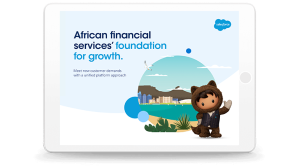Automation for Better Banking Experiences



Read this blog to learn the most notable learnings about consumer behaviour and preferences from the Future of Financial Services report.
Salesforce Authors
Create Easy, Efficient Banking Experiences with Tactical Automation
It’s clear that the future of digital banking lies in using automation to create high-value customer experiences. Take this statistic, for example: among banking customers, 35% switch providers for an easy-to-use digital interface and user experience. Automation, from automatic coin counters to AI technology, drives efficiency and delights customers.
Salesforce recently conducted a study on consumer behaviour and preferences and created The Future of Financial Services report. It includes interesting insights into customer behaviours and ways businesses are using automation to improve customer experiences in banking. Here’s a sample: only 28% of banking customers are satisfied with their provider’s ability to resolve customer issues and inquiries swiftly — a concern automation can help address. Below, you’ll find more of the most notable learnings from the report.
Finding automation opportunities to benefit the customer and employee
Automation in banking can have widespread benefits. This applies to not only the customer (in both B2B and B2C banking) but also the business and its employees. It offers efficiencies, often minimising paperwork and simplifying processes. This allows employees to focus their time on the most important tasks. It also decreases customer wait times and can influence the business’s bottom line. Specific opportunities for automation include mortgages and loans, cyber security and identity verification, and customer satisfaction surveys.
Learn more about the future of digital banking with Salesforce’s report
The insights don’t stop here. You can explore automation further with our full report on ‘The Future of Financial Services’

Mortgages and loans
Applying (and getting approved) for a mortgage or a loan requires a lot of paperwork. And this takes effort from both the customer and the employee. Automation can help decrease the amount of paperwork and speed up the time it takes to originate loans.
Cyber security and identity verification
Cyber security, like automation, is key to the future of digital banking. Enhanced cyber security measures can help financial institutions stand out from their competition. And, automation can improve a business’s cyber security and strengthen identity verification protocols. For example, banks with automated systems can quickly freeze compromised accounts. Automation can also help support resulting fraud investigations.
Customer satisfaction surveys
Improving customer experiences in banking requires understanding current customer satisfaction. Banks can use an automated process to send customers surveys that collect data on this matter. Surveys can also be personalised based on the customer’s interactions with the bank. The data gathered can inform future decisions around customer experiences. This is key at a time when, according to our study, fewer than one in three digital customers are satisfied with important features of their financial institution. This includes the interface app or website, integration of financial and personal data into customer service offerings, and access and integration of complementary services.
Automation should be done efficiently, and in the right places
While automation in banking can create efficiencies, sometimes there can be too much of a good thing. Overhauling all processes at once can be complicated and expensive. That’s why an incremental approach is needed.
Focusing on automating the most error-prone processes can provide quick value. When you apply automation to particularly problematic spots, banks can get an immediate return on investment (ROI).
The results of our study support an incremental roll-out. Our findings showed that customers want efficient services but don’t need end-to-end automation. Instead, banks should focus on improving the parts of the business that hurt the customer experience.
Reporting and insights go hand in hand with automation
Everything doesn’t stop once you put automation in place. Digitising processes can increase the data available to financial institutions. Once you have this data, the next step is to evaluate it — and then act on it.
Reporting and insights can further strengthen the business and benefit customers. The wealth of new data from automation allows banks to create sophisticated reports.
Reporting and automation complement each other and can help banks understand what is working, determine where to expand automation and make better decisions.
Customers may not always recognise the need for automation, but reporting can highlight the truth. In some cases, reporting insights can help banks understand the customer experience better than even the customer. Businesses can use these insights to plan future automation. Even once automation is in place, customers won’t always recognise its role but they will receive better — and faster — service. For example, smooth digital interactions are often the result of automating previously time-consuming middle-office tasks.
Learn more about the future of digital banking with Salesforce’s report
The insights don’t stop here. You can explore automation further with our full report on ‘The Future of Financial Services’
















